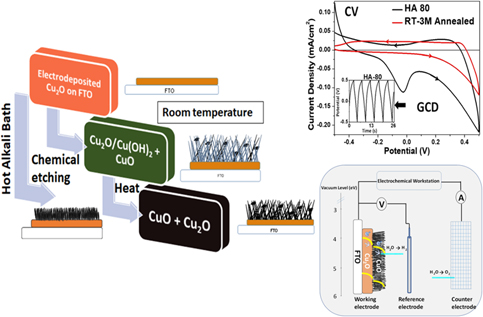Crossref Citations
This article has been cited by the following publications. This list is generated based on data provided by
Crossref.
He, Yezeng
Zhang, Xiaolong
Wang, Shitong
Meng, Jiaxi
Sui, Yanwei
Wei, Fuxiang
Qi, Jiqiu
Meng, Qingkun
Ren, Yaojian
and
Zhuang, Dongdong
2020.
Rubik’s cube-like Ni3S4/CuS2 nanocomposite for high-performance supercapacitors.
Journal of Alloys and Compounds,
Vol. 847,
Issue. ,
p.
156312.
Kottappara, Revathi
Pillai, Suresh C.
and
Kizhakkekilikoodayil Vijayan, Baiju
2020.
Copper-based nanocatalysts for nitroarene reduction-A review of recent advances.
Inorganic Chemistry Communications,
Vol. 121,
Issue. ,
p.
108181.
Marathey, Priyanka
Khanna, Sakshum
Patel, Biren
and
Ray, Abhijit
2020.
Investigation of spray pyrolyzed copper oxide as a photocathode in photoelectrochemical energy conversion.
Materials Today: Proceedings,
Vol. 28,
Issue. ,
p.
883.
Omar, Ahmad
and
Qasrawi, Atef F.
2020.
Enhancement of Nonlinear Optical and Dielectric Properties of Cu2O Films Sandwiched with Indium Slabs.
physica status solidi (b),
Vol. 257,
Issue. 5,
Khanna, Sakshum
Marathey, Priyanka
Utsav
Patel, Roma
Paneliya, Sagar
Chaudhari, Rakesh
Vora, Jay
Ray, Abhijit
Banerjee, Rupak
and
Mukhopadhyay, Indrajit
2021.
Unravelling camphor mediated synthesis of TiO2 nanorods over shape memory alloy for efficient energy harvesting.
Applied Surface Science,
Vol. 541,
Issue. ,
p.
148489.
Kongvarhodom, Chutima
Nammahachak, Nant
Tippomuang, Wannapong
Fongchaiya, Somboon
Turner, Carl
and
Ratanaphan, Sutatch
2021.
Role of crystallographic textures on the growth of CuO nanowires via thermal oxidation.
Corrosion Science,
Vol. 193,
Issue. ,
p.
109898.
Gubicza, Jenő
Jenei, Péter
Han, Gigap
Hung, Pham-Tran
Song, Youngseok
Park, Dahye
Szabó, Ábel
Kádár, Csilla
Kim, Jae-Hun
and
Choe, Heeman
2021.
Effect of Heat Treatment on the Microstructure and Performance of Cu Nanofoams Processed by Dealloying.
Materials,
Vol. 14,
Issue. 10,
p.
2691.
Jun Seo, Young
Arunachalam, Maheswari
Ahn, Kwang-Soon
and
Hyung Kang, Soon
2021.
Integrating heteromixtured Cu2O/CuO photocathode interface through a hydrogen treatment for photoelectrochemical hydrogen evolution reaction.
Applied Surface Science,
Vol. 551,
Issue. ,
p.
149375.
Zhou, Bo
Zhang, Yiqiong
Wang, Tehua
Zhou, Wang
Liu, Jilei
Zou, Yuqin
Tao, Li
Lu, Yanbing
and
Wang, Shuangyin
2021.
Room-temperature chemical looping hydrogen production mediated by electrochemically induced heterogeneous Cu(I)/Cu(II) redox.
Chem Catalysis,
Vol. 1,
Issue. 7,
p.
1493.
Marathey, Priyanka
Khanna, Sakshum
Patel, Roma
Mukhopadhyay, Indrajit
and
Ray, Abhijit
2021.
Proceedings of the 7th International Conference on Advances in Energy Research.
p.
1383.
Marathey, Priyanka
Patel, Biren
Khanna, Sakshum
Vanpariya, Anjali
and
Ray, Abhijit
2021.
Photoelectrochemical characteristics of electrodeposited cuprous oxide with protective over layers for hydrogen evolution reactions.
International Journal of Hydrogen Energy,
Vol. 46,
Issue. 30,
p.
16431.
Stavrou, Michalis
Papaparaskeva, Georgia
Stathis, Aristeidis
Stylianou, Andreas
Turcu, Rodica
Krasia-Christoforou, Theodora
and
Couris, Stelios
2021.
Synthesis, characterization and nonlinear optical response of polyelectrolyte-stabilized copper hydroxide and copper oxide colloidal nanohybrids.
Optical Materials,
Vol. 119,
Issue. ,
p.
111329.
Majumdar, Dipanwita
and
Ghosh, Srabanti
2021.
Recent advancements of copper oxide based nanomaterials for supercapacitor applications.
Journal of Energy Storage,
Vol. 34,
Issue. ,
p.
101995.
Khanna, Sakshum
Utsav
Marathey, Priyanka
Paneliya, Sagar
Vanpariya, Anjali
Ray, Abhijit
Banerjee, Rupak
and
Mukhopadhyay, Indrajit
2021.
Fabrication of silicon nanohorns via soft lithography technique for photoelectrochemical application.
International Journal of Hydrogen Energy,
Vol. 46,
Issue. 30,
p.
16404.
Khanna, Sakshum
Marathey, Priyanka
Paneliya, Sagar
Chaudhari, Rakesh
and
Vora, Jay
2022.
Fabrication of rutile – TiO2 nanowire on shape memory alloy: A potential material for energy storage application.
Materials Today: Proceedings,
Vol. 50,
Issue. ,
p.
11.
El Attar, Anas
Chemchoub, Sanaa
Diallo Kalan, Mamadou
Oularbi, Larbi
and
El Rhazi, Mama
2022.
Designing New Material Based on Functionalized Multi-Walled Carbon Nanotubes and Cu(OH)2–Cu2O/Polypyrrole Catalyst for Ethanol Oxidation in Alkaline Medium.
Frontiers in Chemistry,
Vol. 9,
Issue. ,
Khanna, Sakshum
Marathey, Priyanka
Paneliya, Sagar
Vinchhi, Prerna
Chaudhari, Rakesh
and
Vora, Jay
2022.
Fabrication of graphene/Titania nanograss composite on shape memory alloy as photoanodes for photoelectrochemical studies: Role of the graphene.
International Journal of Hydrogen Energy,
Vol. 47,
Issue. 99,
p.
41698.
Marathey, Priyanka
Khanna, Sakshum
Paneliya, Sagar
and
Vanpariya, Anjali
2022.
Fabrication of copper oxide nanostructures for visible-light photodetector.
Materials Today: Proceedings,
Vol. 50,
Issue. ,
p.
129.
Hongrutai, Nattaphon
Nganglumpoon, Rungkiat
Watmanee, Suthasinee
Pinthong, Piriya
Szilágyi, Petra Ágota
Wongpreedee, Kageeporn
and
Panpranot, Joongjai
2023.
Nanocrystalline Ag–C Composites Containing a Hexagonal Diamond Structure to Inhibit Tarnishing of Sterling Silver.
ACS Applied Nano Materials,
Vol. 6,
Issue. 18,
p.
17060.
Gautam, Pushpa
De, Arup Kumar
Rao, Mudila Dhanunjaya
Sinha, Indrajit
Behera, Chhail Kumar
and
Singh, Kamalesh Kumar
2023.
Waste remediation: Low-temperature synthesis of hybrid Cu(OH)2/CuO and CuO nanostructures from spent printed circuit boards and their dye degradation studies.
Environmental Science and Pollution Research,





